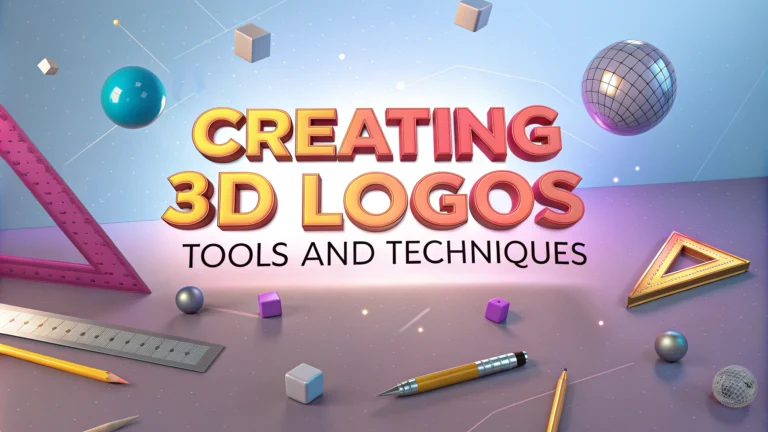3D logos stand out in brand design by adding depth, realism, and visual interest that flat designs simply can’t match.
Essential Tools for 3D Logo Design
- Blender – Free, open-source 3D software with powerful modeling capabilities
- Cinema 4D – Professional-grade tool known for its user-friendly interface
- Adobe Dimension – Integrates seamlessly with other Adobe products
- Maya – Industry-standard software used by professional studios
- ZBrush – Excellent for organic shapes and detailed sculpting
Basic Techniques
Start with a simple 2D design and extrude it to create basic 3D shapes.
Apply materials and textures to give your logo realistic properties like metal, glass, or plastic finishes.
Use proper lighting setups to enhance depth and create dramatic shadows.
Advanced Tips
- Create beveled edges for a more polished look
- Experiment with different camera angles
- Add subtle animations for digital applications
- Consider how the logo will look when scaled down
Common Materials for 3D Logos
| Material | Best Used For |
|---|---|
| Chrome/Metal | Technology, automotive brands |
| Glass | Luxury, modern brands |
| Plastic | Consumer products, toys |
| Wood | Eco-friendly, natural brands |
File Formats
- .obj – Universal 3D file format
- .fbx – Good for animations
- .c4d – Cinema 4D native format
- .blend – Blender native format
Resources
Learn 3D modeling basics through online platforms like LinkedIn Learning or Udemy.
Download free 3D models and textures from TurboSquid or CGTrader to study professional techniques.
Technical Requirements
- Minimum 16GB RAM
- Dedicated graphics card (NVIDIA or AMD)
- Multi-core processor
- SSD storage for faster file handling
Test your 3D logo designs across different platforms and sizes to ensure consistent visibility.
Consider creating simplified 2D versions for situations where 3D rendering isn’t practical.
Export final designs in multiple formats to accommodate different usage scenarios.
Rendering Optimization
Optimize render settings to balance quality and processing time. Lower resolution test renders help quick iterations before final high-quality outputs.
Key Render Settings
- Sample count for anti-aliasing
- Global illumination quality
- Shadow resolution
- Ambient occlusion settings
Color Theory in 3D
Apply color theory principles specifically for 3D space, accounting for light interaction and material properties.
- Use complementary colors for contrast
- Consider how materials affect color perception
- Test colors under different lighting conditions
Version Control
Maintain organized file structures and version control for complex 3D logo projects.
- Save incremental versions
- Back up project files regularly
- Document material and lighting setups
- Keep reference files organized
Client Presentation
Present 3D logos effectively to clients using multiple views and applications.
| View Type | Purpose |
|---|---|
| Static Renders | Print and static digital media |
| Animations | Video and web applications |
| Interactive 3D | Web-based visualization |
Conclusion
3D logo design requires technical expertise, artistic vision, and careful consideration of practical applications. Success depends on choosing appropriate tools, mastering fundamental techniques, and understanding how different materials and lighting affect the final result. Regular practice, continuous learning, and attention to detail are essential for creating professional 3D logos that effectively represent brands across various media.
Remember to balance creative ambition with practical constraints, ensuring the logo remains effective in all required applications while maintaining its visual impact and brand message.
FAQs
- What software is best for creating 3D logos?
Cinema 4D, Blender, Maya, and Adobe Dimension are among the top software choices for creating professional 3D logos. Blender is free and open-source, while Cinema 4D is known for its user-friendly interface. - How long does it typically take to create a 3D logo?
A professional 3D logo can take anywhere from 4-20 hours depending on complexity, revisions, and rendering time. Simple designs might take less time, while complex animations require more. - What are the essential elements of a good 3D logo?
A good 3D logo needs proper lighting, texturing, perspective, shadows, and appropriate material properties. It should maintain legibility from multiple angles and work well in both static and animated forms. - How much computer processing power do I need for 3D logo design?
A minimum of 16GB RAM, dedicated graphics card with 4GB VRAM, and a multi-core processor is recommended. Rendering complex 3D logos requires significant processing power. - What file formats should I deliver for a 3D logo?
Common deliverable formats include .OBJ or .FBX for 3D files, .PNG or .TIF with transparency for static images, and .MOV or .MP4 for animations. Source files in the native 3D software format should also be provided. - How do I ensure my 3D logo works well in different sizes?
Design with scalability in mind, avoid overly complex details, test at various sizes, and create different versions optimized for different applications (web, print, video). - What rendering engines are best for 3D logos?
V-Ray, Arnold, and Redshift are popular choices for photorealistic rendering. Built-in engines like Cycles in Blender can also produce excellent results. - How do I create metallic and glossy effects in 3D logos?
Use PBR (Physically Based Rendering) materials, adjust reflection and specular properties, and implement proper environmental lighting for realistic metallic and glossy effects. - What’s the difference between polygon and NURBS modeling for logos?
Polygon modeling uses flat surfaces connected by vertices, ideal for hard-surface designs. NURBS creates smooth, curved surfaces better suited for organic shapes. - How do I optimize 3D logos for web use?
Reduce polygon count, optimize textures, use appropriate compression, and consider using WebGL for interactive 3D logos. Export in web-friendly formats and sizes.







